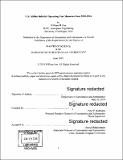| dc.contributor.advisor | Peter P. Belobaba. | en_US |
| dc.contributor.author | Lee, William H., S.M. Massachusetts Institute of Technology | en_US |
| dc.contributor.other | Massachusetts Institute of Technology. Department of Aeronautics and Astronautics. | en_US |
| dc.date.accessioned | 2018-11-28T15:42:23Z | |
| dc.date.available | 2018-11-28T15:42:23Z | |
| dc.date.copyright | 2018 | en_US |
| dc.date.issued | 2018 | en_US |
| dc.identifier.uri | http://hdl.handle.net/1721.1/119305 | |
| dc.description | Thesis: S.M., Massachusetts Institute of Technology, Department of Aeronautics and Astronautics, 2018. | en_US |
| dc.description | Cataloged from PDF version of thesis. | en_US |
| dc.description | Includes bibliographical references (pages 140-147). | en_US |
| dc.description.abstract | This thesis investigates the evolution of U.S. airlines' unit operating costs from 2000-2016 as well as the factors that drove major changes in cost metrics. We assess the trends in operating cost by carrier type as well as for individual airlines and find evidence of a recent operating cost divergence between the legacy carriers and their lower cost counterparts. Since 2014, legacy carriers' unit costs, excluding transport-related and fuel expenses, have risen 6% while low cost carriers and ultra-low cost carriers have seen decreases of 1.6% and 10%, respectively. We see the increase in legacy carriers' unit costs has been driven almost entirely by unit labor costs, which have increased 16% since 2014. While the recent operating cost divergence is attributed in large part to changes in labor costs, we recognize the impacts network characteristics impart of unit operating costs. In order to confirm and quantify the principal drivers of operating cost differences between airlines, we conducted several econometric analyses. We found average stage length per departure, employee productivity (measured as output per employee), average seats per departure, and aircraft utilization to be significant in explaining unit cost differences. For every 1 % increase in each metric operating costs, excluding transport-related and fuel expenses, are estimated to decrease by 0.31%, 0.25%, 0.54%, and 0.50%, respectively. We then perform a more detailed analysis on unit labor costs. We find pilot total compensation has risen for all three carrier types and is almost entirely responsible for the increase in labor costs among the U.S. airlines in our sample. Since 2012, Alaska and Spirit Airlines have been the only airlines that have not seen higher unit total pilot compensation. Our investigation revealed how distortions may be introduced when normalizing pilot compensation by ASMs for purposes of comparing different airlines and conclude by proposing a new normalized metric, seat block hours. | en_US |
| dc.description.statementofresponsibility | by William H. Lee. | en_US |
| dc.format.extent | 147 pages | en_US |
| dc.language.iso | eng | en_US |
| dc.publisher | Massachusetts Institute of Technology | en_US |
| dc.rights | MIT theses are protected by copyright. They may be viewed, downloaded, or printed from this source but further reproduction or distribution in any format is prohibited without written permission. | en_US |
| dc.rights.uri | http://dspace.mit.edu/handle/1721.1/7582 | en_US |
| dc.subject | Aeronautics and Astronautics. | en_US |
| dc.title | U.S. airline industry operating cost measures from 2000-2016 | en_US |
| dc.title.alternative | United States airline industry operating cost measures from 2000-2016 | en_US |
| dc.type | Thesis | en_US |
| dc.description.degree | S.M. | en_US |
| dc.contributor.department | Massachusetts Institute of Technology. Department of Aeronautics and Astronautics | |
| dc.identifier.oclc | 1061861129 | en_US |
